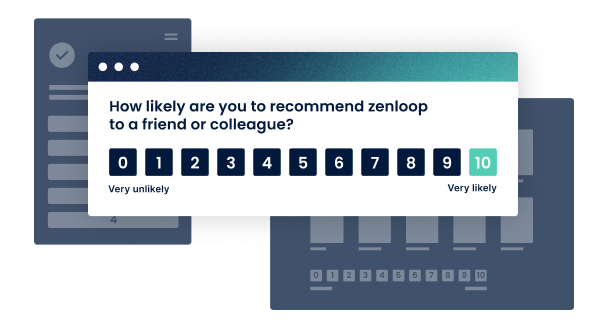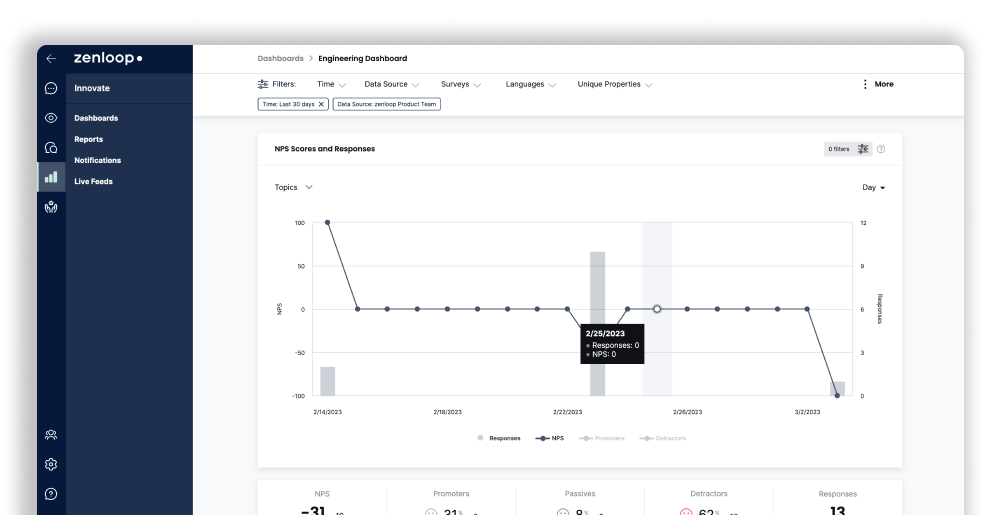The Net Promoter Score® (NPS®)
Directly Determine Customer Satisfaction
Determining customer satisfaction is not always easy. It is not always immediately clear why purchases have been canceled or negative reviews given. The US developed Net Promoter System® with the Net Promoter Score (abbreviated: NPS) at its core, companies can use a simple and proven methodology to collate and evaluate customer satisfaction through direct feedback.
NPS is a type of micro customer survey that combines a rating scale from 0 to 10 with a free text field. Customer participation is requested, for example, via email, as an in-app feature or via a website. It provides honest customer feedback where each participant can justify their answer in the accompanying text field. The same question is always asked: „How likely are you to recommend X to a friend or colleague“, where the name of the company, product purchased or the service used takes the place of „X“.
Table of Contents
- The Customer Groups: Promoters, Indifferents, and Detractors
- Comparing the Net Promoter Score
- Conducting Micro Surveys to Determine NPS
- Individualizing NPS Surveys
- Practical calculation of the Net Promoter Score
- Keeping in Touch with the Customer: Feedback Loops
- Correctly Using Knowledge Gained Through NPS
- Determining Employee Satisfaction Using eNPS
The Customer Groups: Promoters, Indifferents, and Detractors
After collecting data, the Net Promoter Score is determined based on the three possible groups that the customers fall into: Promoters (fans), Indifferents or Passives (undecided), and Detractors (dissatisfied). The total score for the evaluated company derives from the percentage of promoters minus the percentage of detractors. Depending on the value, the value is between -100 and +100. The lower the calculated value, the less satisfied the customers are and the less likely they would recommend the company.
The three customer groups that are distinguished from one another on the basis of NPS are characterized in detail as follows:
- Promoters (9-10 points on the scale):
These “fans” of a company are a very significant group. They are loyal customers who actively recommend the brand and thus help to win new customers. The goal of the effort should be to attract as many promoters as possible. - Indifferents or Passives (7-8 points on the scale):
These are “passive“ customers who have already bought but are now more of an undecided. They are not 100 percent satisfied and a recommendation is rather unlikely. - Detractors (0-6 points on the scale):
These critics do not have a good opinion of the company and advise friends, acquaintances, and other potential new customers not to buy. This can be based on a single bad experience with a service or product. Detractors are important drivers of improvement and their comments should be taken very seriously.
Comparing the Net Promoter Score
The data obtained clearly shows the marketing department which way the wind is blowing and highlights potential for both improvement and new strategies. Ongoing use of NPS enables benchmarking, both for internal control and for external comparison with competitors. By comparing your previous values with current ones, you can also track the relative success of your own strategy implementation. This supports companies in maintaining their competitiveness. Evaluating the additional comment provides the company also receives unfiltered feedback and therefore valuable information on the specific customer pain points. Such customer feedback is of enormous value for the further development of every company
In short, a comparison of scores with that of competitors or, if applicable, your own partner company only makes sense within the same country and industry. Mentality and service expectations differ from country to country. For example, the average NPS in Germany falls generally rather low in international comparison. Whilst customers in the USA express their fullest satisfaction with a 10, this value is lower in Germany and China and is 7 to 8. In Malaysia too, the maximum value is 7, and points 8 to 10 are practically not used. In Germany, a rating between 7 and 8 can be considered very good, which must also be taken into account when evaluating the numbers.
Conducting Micro Surveys to Determine NPS
The Net Promoter System‘s greatest strength is its brevity and the resulting high response rate. These micro surveys are only 1-2 minutes long, meaning most customers are willing to invest the time to answer the survey. The request takes place in pop-up windows, e-mails, or at carefully chosen places on the website where the customer currently is. Participation is easy and uncomplicated.
Before carrying out the customer survey, it is vital to define what should actually be learned. This could be:
- Do customers know my products or do I have to change my communication strategy?
- Which product features are important to customers and which are less important?
- What expectations do customers have?
Building on this, the survey can now be designed in just a few steps. This makes NPS surveys a relatively simple tool for obtaining customer opinions. Once the survey goal is set, only a few factors need to be considered. It is however recommended to start with a general customer satisfaction survey before targeting individual touchpoints.
NPS micro surveys can be divided into two kinds:
- NPS Relationship Survey: used to measure customer loyalty and the general attitude towards a brand. This shows which touchpoints and processes have problems that need to be examined in more detail.
- NPS Transactional Survey: is an instrument for measuring customer satisfaction at specific touchpoints or for certain interactions – it can be carried out, for example, after purchase and again after delivery.


Individualizing NPS Surveys
Each survey should be tailored to its own target group, both in terms of design and content. It goes without saying that a survey should fit into the design of the website or online shop and should not be perceived as disturbing. This raises the participation rate. Setting up the survey based on the language used by the target group removes an additional hurdle to participation.
Another important aspect is the individual design of the NPS scale. While it ranges from 1 to 10 by default, companies can increase the meaningfulness of the Net Promoter Score by adjusting and shortening the scale. However, it should always have an odd number of values in order to make neutral opinions possible. Since many factors such as usage habits, education, and age are often not known, it is important to make the scale as simple as possible.
Time Intervals for Determining NPS
Raising and increasing customer satisfaction is an effort that companies should track permanently to stay competitive in rapidly changing markets. The combination of ongoing, selective use of relationships and transactional surveys brings optimal results. Companies typically collect the Net Promoter Score quarterly, semi-annually, or annually. However, analysis at shorter intervals offers the opportunity to react faster to customer dissatisfaction and „turn the frown around“.
Practical calculation of the Net Promoter Score
Once the survey results have been processed, the calculation begins. Basically, the score is made up of the difference between detractors and promoters. It can be calculated in two ways.
Manual Calculation
The sequence of events is as follows:
- Allocation of the individual scale values to the customer groups (detractors, indifferents, and promoters)
- Allocation of the respondents to the three customer groups
- Determination of the total sum of all answers within each group
- Determination of the percentage: the respective sum of the three groups is divided by the total number of answers
- The percentage of the detractors is subtracted from the percentage of the promoters
- The result is a number that ranges between -100 and +100
This number thus obtained is the Net Promoter Score, which serves as a benchmark for corporate development and gives a good overview of the general level of customer satisfaction. This in turn shows whether the corporate strategy works or should be adjusted.
The online calculation of the NPS can be done with our zenloop online NPS calculator.
Automatic Calculation with NPS Feedback Software
If manual calculation is too tedious, you should consider looking at the zenloop NPS feedback software. With it, evaluation and feedback are automatically collected, semantically evaluated, tagged, and made available as reports. This intelligent software solution saves time and delivers in-depth insights almost at the push of a button. The smart system uses semantic analysis to recognize the customer’s written feedback and categorize it into groups defined by the company. Permanent monitoring allows for trend detection and thus supports both short and long-term strategic decisions. Real-time feedback enables short reaction times and critical aspects can be immediately forwarded to the appropriate internal spot.
Keeping in Touch with the Customer: Feedback Loops
On their way from prospect to customer, the user interacts with the company at many points on the customer journey. Continuous surveys within the Net Promoter System provide information about satisfaction all along this path – but the choice of touchpoints to survey depends on the goal and type of feedback needed. The multi-stage process of collecting feedback and the company’s response to it takes place within feedback loops which usually come to an end with the completion of a purchase or the handling of a complaint.
The enterprise analyzes the feedback received from customers along the customer journey and converts these into concrete measures which may then also entail further customer interactions. In this way and under certain circumstances customer behavior can be influenced. A short online survey could be activated after the end of a service call, or immediately after completing a purchase, for example.
An optimally executed feedback loop opens the door to requesting positive customer reviews on evaluation platforms. It is important to inquire about satisfaction shortly after customer interaction with the company is completed, for example after delivery. If the customer journey passes through feedback loops that convert negative aspects into positive experiences, the customer is now willing to give a good rating. Now is the right time to actively suggest that he submit a review on a preferred platform.
Correctly Using Knowledge Gained Through NPS
Brand promoters are worth their weight in gold. They are satisfied, passionate advocates of the company and valuable multipliers. With strategic referral marketing, one can take advantage of promoters’ beliefs.
Satisfied customers usually recommend a company to:
- Friends, acquaintances, and family
- Existing and past customers
- Users of online networks, forums, and social media
- Their wider environment, for example, neighbors
With the targeted use of special offers and programs – for example, a customer recruiting program – marketers can increase the referral rate. The influence of influencers should not be underestimated!
Detractors should not be written off either. Using the right kind of preventive and reactive measures can ensure winning back dissatisfied customers.
And it can be worth it: keeping an existing customer costs an online retailer an average of five to seven times less money than winning over a new one. The ROI (return on investment) in e-commerce is therefore significantly higher for existing customer loyalty than for new customer acquisition.
If you pay attention to the warning signals transmitted by customers who are leaving, you can react early and prevent the death of the business relationship. Indications of growing dissatisfaction can be a:
- Drop in turnover
- Define in orders
- Decrease in contact frequency
For the planning – and especially prioritization – of concrete measures, it is important for the company to know the value of each customer. The customer lifetime value is a key metric that classifies this figure. It is made up of the sum of the purchases made so far and this customer‘s forecast earnings. The higher this calculated value, the more the investment is worthwhile in increasing the satisfaction and customer loyalty of that customer.
Determining Employee Satisfaction Using eNPS
In addition to using the Net Promoter Score with customers, it can also deliver important insights into employee satisfaction. If the Net Promoter System is combined with the collection of the eNPS (Employee Net Promoter Score), it becomes an instrument that can serve both employee retention and crisis management. The measurement of employee loyalty through an anonymous survey on the likelihood of recommendation gives important indications of improvement potential.
Determine NPS with zenloop






